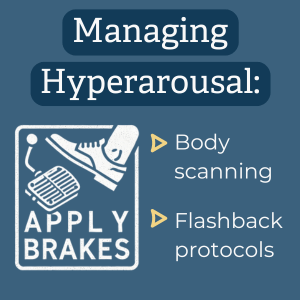Trauma Informed Practice Course
The Competence and Confidence to Work with Trauma in Your Practice.
The following article is taken from our Trauma-Informed Practice course.

The Competence and Confidence to Work with Trauma in Your Practice.
The Dual Awareness Model (DAM) is a trauma-informed approach designed to help clients navigate the mind-body disconnection that often occurs during dissociation. Developed by Babette Rothschild, the model is pivotal for trauma therapists aiming to help clients maintain awareness of both their current environment and their internal experiences, even when revisiting past traumatic events.
The core of the DAM lies in assisting clients to manage the pull between the past (driven by trauma) and the present (grounded in current safety), thereby preventing the trauma from reactivating with the same intensity.

Dual awareness is the capacity to recognise that while a traumatic memory may trigger intense feelings, the client remains aware that they are in the present moment, distinct from the trauma of the past. This is crucial in trauma therapy because the limbic system often causes the client to feel as though they are reliving the trauma, even though they are physically in a different, safer context. Rothschild emphasises that the counsellor’s role is to guide the client in separating these experiences—anchoring them in the present through body awareness.

The exteroceptive and interoceptive systems play an essential role in how trauma survivors process their experiences. The exteroceptive system focuses on external stimuli, using the five senses (sight, hearing, taste, smell, touch) to gauge the environment. On the other hand, the interoceptive system includes proprioception (awareness of body parts in space) and vestibular perception (sense of balance and relationship with gravity).
Understanding these sensory systems allows you to help clients differentiate between their internal sensations (which may be tied to past trauma) and the current external environment, which may be safe. This differentiation supports self-regulation, helping clients avoid becoming overwhelmed by internal stimuli.
Body scanning is a key technique within the Dual Awareness Model framework, facilitating a client’s ability to stay grounded in the present. Rothschild advises that counsellors ask clients to observe their bodily sensations, encouraging an active awareness of how their bodies feel in the moment. By doing so, clients become more attuned to their physical states, helping them regulate when they feel overwhelmed.
For example, Rothschild suggests simple questions such as, “What are you aware of in your body right now?” or, “Did you notice your breathing?” These questions prompt clients to shift their focus from the distressing memory to their current physiological experience, reducing the likelihood of dissociation.

Flashbacks are common in trauma survivors, often triggered by sensory cues that resemble the traumatic event. The Flashback Halting Protocol (FHP) is designed to bring clients back to the present by guiding them through structured, repetitive statements affirming the reality of the present and the origin of their distress.
The protocol follows these steps:
This structured approach offers the client a cognitive and somatic anchor in the present, helping to disrupt trauma’s emotional and physiological reactivation.

Rothschild stresses the importance of applying brakes before using the accelerator in trauma therapy. This means ensuring the client has the tools to manage their arousal levels before diving into intense trauma work. Hyperarousal, if left unchecked, can lead to dissociation, where the client becomes overwhelmed and mentally transported back to the time of trauma.
Body scanning and flashback protocols are vital for you to help clients regulate their autonomic responses, maintaining their presence in the here and now.
To successfully implement the Dual Awareness Model, counsellors and psychotherapists must maintain an adaptive approach, tailoring interventions to the client’s needs. Rothschild emphasises that trauma therapy requires flexibility, as different clients will respond to interventions in unique ways. As the therapist, you must be attuned to the client’s internal resources (e.g. coping mechanisms) and external resources (e.g. their physical and social environment).
In practice, therapists are encouraged to:
The Dual Awareness Model provides a comprehensive framework for working with trauma survivors, integrating somatic awareness with cognitive interventions. Therapists who apply this model can help clients navigate the complex relationship between their past traumas and present realities, fostering greater self-regulation and resilience.
As Rothschild suggests, the more familiar clients become with their bodily sensations, the less fear they associate with them. This dual approach empowers clients to reclaim control over their responses to trauma, promoting healing and growth.
Child Success Center. (2019). Understanding Interoception – New Insights into Common Childhood Issues. Available from: https://childsuccesscenter.com/blog/interoception-common-childhood-issues/
Rothschild, B. (2000). The Body Remembers: The Psychophysiology of Trauma and Trauma Treatment. Los Angeles: W.W. Norton & Company.
Porges, S. (2011). The Polyvagal Theory: Neurophysiological Foundations of Emotions, Attachment, Communication, and Self-regulation. New York: W.W. Norton & Company.
Notice any broken link or issues with this resource? Kindly let us know by email
Email us